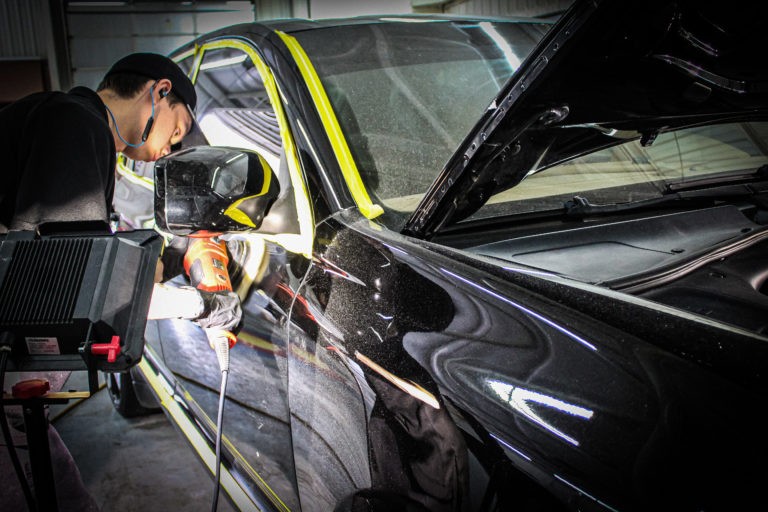Before beginning an auto paint correction project, you should understand the process first. There are several different techniques and methods. Read this article to learn more about each. You will learn about the success rate and cost of auto paint correction. Then, you can decide if this type of work is right for you. You should also know the importance of the right equipment. The right tools can make a world of difference. But what should you look for in an auto paint correction company?
Techniques Used in Auto Paint Correction
Paint correction is a multi-step process that removes imperfections from a vehicle’s clear coat. Unlike detailing, paint correction involves many additional steps to achieve a mirror-like finish. It is also time-consuming, with the entire process taking six to eight hours to complete. A professional must perform multiple polishing steps to get a flawlessly refinished finish, and the results are worth it. If you’re in need of a touch up for your vehicle’s paintwork, a trusted auto repair workshop is your best bet.
Before you get started, you’ll need to determine which areas of your car’s paintwork need correction. In general, the horizontal surface receives the most elemental, UV, and topical contamination. Paint correction techniques include removing oxidation, which often causes dull patches on horizontal surfaces. To make this process easier, you can buy the tools you need at your local auto parts store or home improvement store. For chemicals that are effective against oxidation, check out Fortador, which has a comprehensive line of products. Make sure to use good lighting to ensure you get good results.
Auto paint correction techniques remove scratches and marring from the surface of a car’s paint. Some are done to improve the look of a vehicle, while others are performed to prepare it for a ceramic coating. Some techniques are applied in order to eliminate light swirls, holograms, and flaking clear coat. Other techniques remove swirl marks, remove bonded contaminants, and prepare the surface for a protective coating.
The Cost of Auto Paint Correction
The price of auto paint correction varies greatly depending on the vehicle’s condition and size. Larger vehicles require more work and materials than smaller ones. Also, customers’ expectations will affect the cost of paint refinement. Here are some tips to keep the cost low. 1.Do not skimp on quality. Better quality paint can last longer than cheap paint. 2. Plan your auto paint correction expenses carefully. Avoid making impulsive purchases that increase the bill.
The process of paint correction requires an ample amount of time. Professional detailers charge anywhere from $50 to $100 per hour. This price does not include the profit they make. You can get the job done at home for a fraction of the price of hiring a professional. But the time-consuming process can easily break the budget. Therefore, you should budget for the time needed to complete the entire process. A typical car paint correction takes a full day.
A professional paint correction can improve the look of your vehicle. The cost depends on the extent of the correction needed and the type of car. A simple paint correction can cost between $300 and $500. More serious corrections, however, may require seven days and 50 hours of polishing. In addition, you should plan to spend a few hundred dollars more if you want paint protection. You may even be able to save up to half that cost yourself if you do it yourself.
Auto Paint Correction Success Rate
While the success rate of auto paint correction is not entirely dependent on the amount of time and money spent, it is crucial to ensure consistency in the process. Some detailers enroll in training courses that cost upwards of $1,000. If you’re looking for an affordable option, you can try using an app designed for the industry. It can help you decide on the price of your work and also set a maintenance wash schedule. The results of the paint correction should last for at least five years with proper maintenance and timely touch-up.
Paint Correction Works in Two Stages: Stage One and Stage Two Stage one is for cars with light-to-medium defects. The process includes heavy compounding machine polishing and finishing polishing. The second stage includes polishing with a finishing pad and wax. Each process takes between four and eight hours, depending on the amount of paint damage and the level of correction needed. To achieve a high-quality result, a professional should first assess the paint condition and then choose the correct method.
A good auto paint correction service should have its own physical workshop, so you can bring your car back afterward. This is crucial because it shows that the business has the right equipment to complete the job. Also, it’s vital to consider the business’s success rate. You don’t want to hire a service that cannot guarantee a high level of quality but has a low success rate. You can get referrals from your friends and family to choose the best paint correction service for your car. Then, interview a few prospective services before making a decision.
